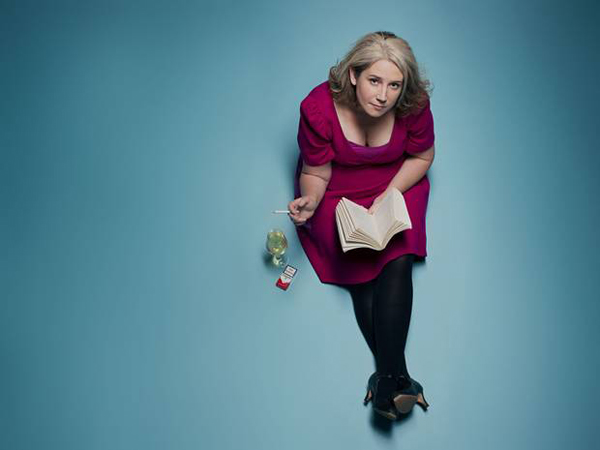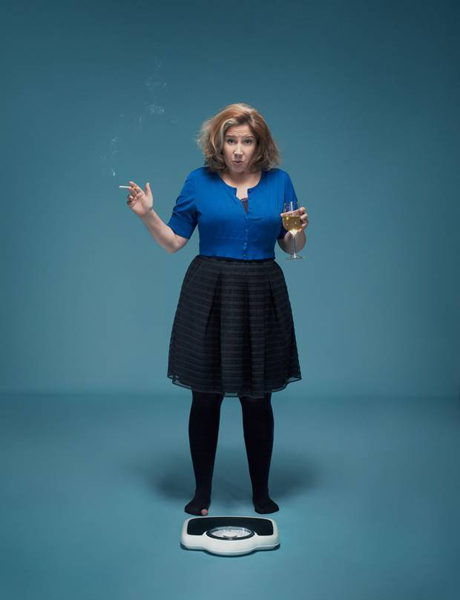Mad about the Girl:The Enduring Appeal of Bridget Jones
© Nick Ballon
In
1996 I was living in a flat in north London with two girlfriends from
university. It was to this flat that we brought bottles of white wine
(yes, Chardonnay), £2 packets of Silk Cut (at one point around this
time I was smoking 40 a day) and a stream of unsuitable men, including,
on one not particularly memorable occasion, a pizza waiter who resembled
Peter Andre. Alessandro was his name. Actually maybe he was not that
forgettable after all. Without
thinking ourselves clichéd, we were living Bridget’s life. We were
all trying half- heartedly to lose weight by eating reduced-fat muffins
and taking skimmed milk in our instant coffee. No one drank latte yet.
We were desperate for people (ideally men who were not pizza waiters) to
take us to cool parties and on mini-breaks. We bought scratchcards. We
dreaded going home to visit our parents for Christmas. This was in the
days when people left home and did not live with their parents until
they were 35. We
were too young – in our mid-20s – to care properly about getting
married. But we did care that we never seemed to find any boyfriends who
were that great. And that the men we really liked were not interested in
us. That was Bridget enough. We drank way too much (or I did, at least)
and, in that embarrassed British way, we dealt with this by making a big
joke of something that was actually quite sad. Alessandro never came
back. Basically,
we were Bridget Jones fans waiting to happen, even though we were nearly
10 years younger than the “real” Bridget and 15 years younger than
her creator, Helen Fielding, who had also almost certainly lived this
sort of life for some time and, by all accounts, was still living it
when she first started writing in Bridget’s voice. At this point
Fielding was a freelance journalist who had got into her late thirties
without a big career break and with the by-now-irritatingly-successful
Richard Curtis as her best friend. (They briefly dated each other when
they were at Oxford.)
© Nick Ballon
The
TV series featured the infamous “lake scene” where Mr Darcy (Colin
Firth) emerged from a bracing swim in a wet white shirt. The New York
Times likened the moment to Marlon Brando shouting “Stella!” in his
vest in A Streetcar Named Desire. The novelist Joanna Briscoe wrote that
the adaptation was “so dominant, so universally adored, [that] it has
lingered in the public consciousness as a cinematic standard”.
Bridget-Jones-the-column was the touchpaper. The all-consuming lust for
Darcy was the fuse. The combination of the two led to the novel Bridget
Jones’s Diary, published in 1996, which became one of the most
successful British fiction exports of the 20th century, setting aside JK
Rowling. Over
the next 10 years, thanks to Renée Zellweger’s willingness to put on
two stone in order to look authentically, chubbily British, Bridget went
global: 40 countries, 15 million copies sold, two Hollywood blockbuster
films which each took over £150m at the box office. Fielding has been
open about the debt to Jane Austen – and to Colin Firth’s portrayal
of Darcy, which he reprised in the films. But she also acknowledges that
Bridget owes her success to something older than time and something that
has nothing to do with being a woman in love with a man she can’t have
(although that is 99.9 per cent of Bridget’s appeal). She has often
hinted that what Bridget is really about is about the idiocy of being
human. Fielding calls her “the original banana-skin girl”. She’s
what we all fear we are, man or woman: an accident waiting to happen.
Women are just more open about it. Some
people respond to this stuff by clicking through to the pre-order link
or enthusiastically typing “Can’t wait!!!!!!!” But there is also a
frenzy of semi-serious answers: “Never drive a man home after first
date.” “Never continue to date a man whose idea of a good first date
involves going to the cinema.” “Don’t wear shoes you can’t walk
in.” (Too late for Bridget judging by the platform stilettoes on the
book’s cover.) This is why Bridget has had a long shelf life: because
as long as she still has the same problems, enough women will identify. It’s
weird, though, that this product of the mid-1990s has endured. Arguably
it’s because Fielding, almost inadvertently, spotted trends before
their time and gave a name to them. The uncomfortable relationship
between “singletons” and “smug marrieds”. The power of
“emotional fuckwittage” (people messing each other around while
dating). The consumerist tendency to list and catalogue food items,
calories and purchases. The tension between being an organic-loving,
hedonist foodie and being a self-depriving, obsessive dieter. Most
of all, she was a blogger before blogs existed. Probably if the whole
business was played out again now Bridget would be lost in the cacophony
of the internet. She was a bridge between the old world, where we were
raised on Pride and Prejudice and Adrian Mole’s diary, and the new,
where readers are now more likely to follow the Twitter account,
“Like” the Facebook page and Kindle the book but never actually read
it. This new book, then, feels like her swan song.
© Nick Ballon
Bridget
has always been more of a political creature than her creator intended
(and more political than her fans care about). Thirty years after Betty
Friedan wrote about “the problem that has no name”, describing the
empty lives of women with no life outside the home, Bridget Jones saw
herself as living “in a state of nameless dread”, with no life
outside her obsession with being single. Camille Paglia and Julie
Burchill bemoaned Bridget’s lack of backbone but Fielding defended
herself: “Nobody worries about what Bertie Wooster is saying about
masculinity.” In
real life, author Helen Fielding has come full circle, which is perhaps
another reason for the launch of this book now. She’s Bridget again,
sort of. Having re-located in Los Angeles, she recently moved back to
north London as a single parent. (She has two children with Kevin
Curran, a TV exec on The Simpsons.) The life of her readers, meanwhile,
has moved on too. I’ve
always been fond of Bridget and I’m happy to see her again. It’s
like catching up with an old friend who never quite moved on. When I
first met her I was a veteran smoker, a big drinker and a confirmed
singleton. I truly believed I would never meet a man. In fact, within
two years of reading the book, at the age of 26, I was married and
within a decade I had three children. I haven’t smoked a cigarette in
over 15 years and am in trouble if I drink more than half a white-wine
spritzer. One thing is left over from that era: the big pants. Not so
much of a joke now. More a necessity. ‘Mad
About the Boy’ is published on 10 October by Jonathan Cape, priced £18.99 What
Bridget would really be like now Comic
characters are tricky. Because they need to grow but they mustn’t age.
This is a massive challenge for Bridget Jones. Her entire appeal once
hung, Jane Austen-style, on the fact, that she was over 30 and
unmarried. Now, in the new book, she’s in her forties and a single
mother. This
is a gamble: it assumes that her fans have moved on and are also in that
part of their lives – and don’t want to see Bridget in her old life.
But they also don’t want to see her totally changed: so the situation
is the same (she’s drunk, hopeless with men and still dieting), but
the circumstances are different (she needs to get a babysitter so she
can go internet dating). The
strange thing, though, is that the original Bridgets are way beyond this
stage and virtually staring grandmotherhood in the face. The date of
birth of the character Bridget Jones is 9 November 1962: she’s nearly
51. Her creator, Helen Fielding, is in her mid-fifties. If
Bridget were really around now, she’d be on HRT, be a member of the
newly emergent Women’s Institute and have a subscription to ‘Woman
and Home’ magazine. It seems unlikely that she’d be on Twitter. But,
yes, granted, she would be doing the 5:2 fast diet. Who isn’t? VG
|


